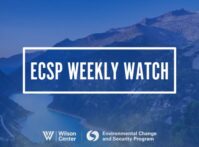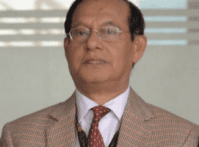-
Swathi Veeravalli on the Importance of Climate Security for US Strategic Interests
November 22, 2024 By Wilson Center Staff In today’s episode of New Security Broadcast, ECSP Program Director Lauren Risi sits down with Swathi Veeravalli on her last day as the Director for Climate Security and Adaptation at the National Security Council (NSC) to discuss the new US Framework for Climate Resilience and Security, its significance for the future of US security and economic interests, and what success in building climate security looks like over the next decade.
In today’s episode of New Security Broadcast, ECSP Program Director Lauren Risi sits down with Swathi Veeravalli on her last day as the Director for Climate Security and Adaptation at the National Security Council (NSC) to discuss the new US Framework for Climate Resilience and Security, its significance for the future of US security and economic interests, and what success in building climate security looks like over the next decade.In today’s episode of New Security Broadcast, ECSP Program Director Lauren Risi sits down with Swathi Veeravalli on her last day as the Director for Climate Security and Adaptation at the National Security Council (NSC). Swathi has been one of the driving forces behind helping the US government better understand and respond to the connections between climate and security through her earlier work at the Army Corps of Engineers and AFRICOM and for the last two years at the NSC. In their conversation, Swathi describes the evolution of her role and the new US Framework for Climate Resilience and Security, its significance for the future of US security and economic interests, and what success in building climate security looks like over the next decade. Select quotes are featured below.
On the US Framework for Climate Resilience and Security
“The administration has really created a bold new playbook that has turned tackling the climate crisis into an enormous economic opportunity, both at home and abroad. And so, the Framework is not the culmination of our efforts, but instead is a steppingstone for the rest of the US government to integrate climate resilience. It is also an opportunity for our partners and allies to operationalize what the United States diplomatic, defense, and intelligence communities have consistently identified as a serious threat to international and national security, and that’s climate change.”
“We know that without action, climate hazards and threats will impact regional stability, including the erosion of decades of progress made in advancing development goals, saving lives, improving livelihoods, and tackling threats to human security. And so, with the Framework, we’re modifying that narrative to demonstrate the immense opportunity associated with climate action.”
“As we currently see it, climate security is about maintaining the resilience of communities coupled with the stability of nations in a changing climate. And that’s why the White House released this Framework as a holistic foreign policy approach to not only counter these national security threats but also realize the opportunities associated with them.”
On the value-add of the Framework
“What is different about the Framework is how it reinforces the importance of economic resilience to lives and livelihoods. For me, the most important contribution of the Framework is the opportunity it affords government employees, partners, and allies to realize climate security for themselves and their portfolio.”
“It’s really marrying the top down with the bottom up, a grass-tops approach, which, borrowing from my previous development hat, is at the agency level and below. So we’re trying to infuse climate security into the DNA of our departments and agencies, as well as work with our partners and allies to be able to realize some of the opportunities associated with climate security.”
On how the Framework works
“Simply put, climate hazards are threatening the long-term stability of our governments, and more importantly, our economies and our global security. The three pillars of the Framework are as follows. First, we seek to assess climate-related threats and opportunities without assessments of impacts of climate on our security and defense.
The second pillar seeks an integrated approach, drawing in partners and allies. Each federal department and agency have unique capabilities and comparative advantages in our response to climate hazards, that we want to utilize. But coordination is critical to efficiently and effectively meet the needs of our communities, both at home and abroad.
Finally, the first two pillars will allow the US and our partners to invest in collective resilience. And for me, this is really the where the Framework has tremendous value. Increasing the resilience of our own investments, including those in our supply chains, physical installations, or the provision of emergency assistance when challenges arise, advances national security objectives and yields economic results. We know that preparedness pays.”
On what success in building climate security looks like over the next decade
“I think in five to 10 years, I hope that the leadership of the United States, our cutting-edge analyses, and partnership and investment are brought to bear on climate and resilience, both at home and abroad. In doing so, I am confident that we’ll be able to turn these many growing vulnerabilities associated with climate into strategic opportunities that impact lives and livelihoods positively.
Through these efforts, we will build more resilient and sustainable global security and one that understands that withstanding climate shocks and disruptions is done better through partnership and investment.”
Photo credit: Swathi Veeravalli at a 2016 Wilson Center event, taken by Wilson Center Staff.
 A Publication of the Stimson Center.
A Publication of the Stimson Center.

 In today’s episode of New Security Broadcast, ECSP Program Director Lauren Risi sits down with Swathi Veeravalli on her last day as the Director for Climate Security and Adaptation at the National Security Council (NSC) to discuss the new US Framework for Climate Resilience and Security, its significance for the future of US security and economic interests, and what success in building climate security looks like over the next decade.
In today’s episode of New Security Broadcast, ECSP Program Director Lauren Risi sits down with Swathi Veeravalli on her last day as the Director for Climate Security and Adaptation at the National Security Council (NSC) to discuss the new US Framework for Climate Resilience and Security, its significance for the future of US security and economic interests, and what success in building climate security looks like over the next decade.





